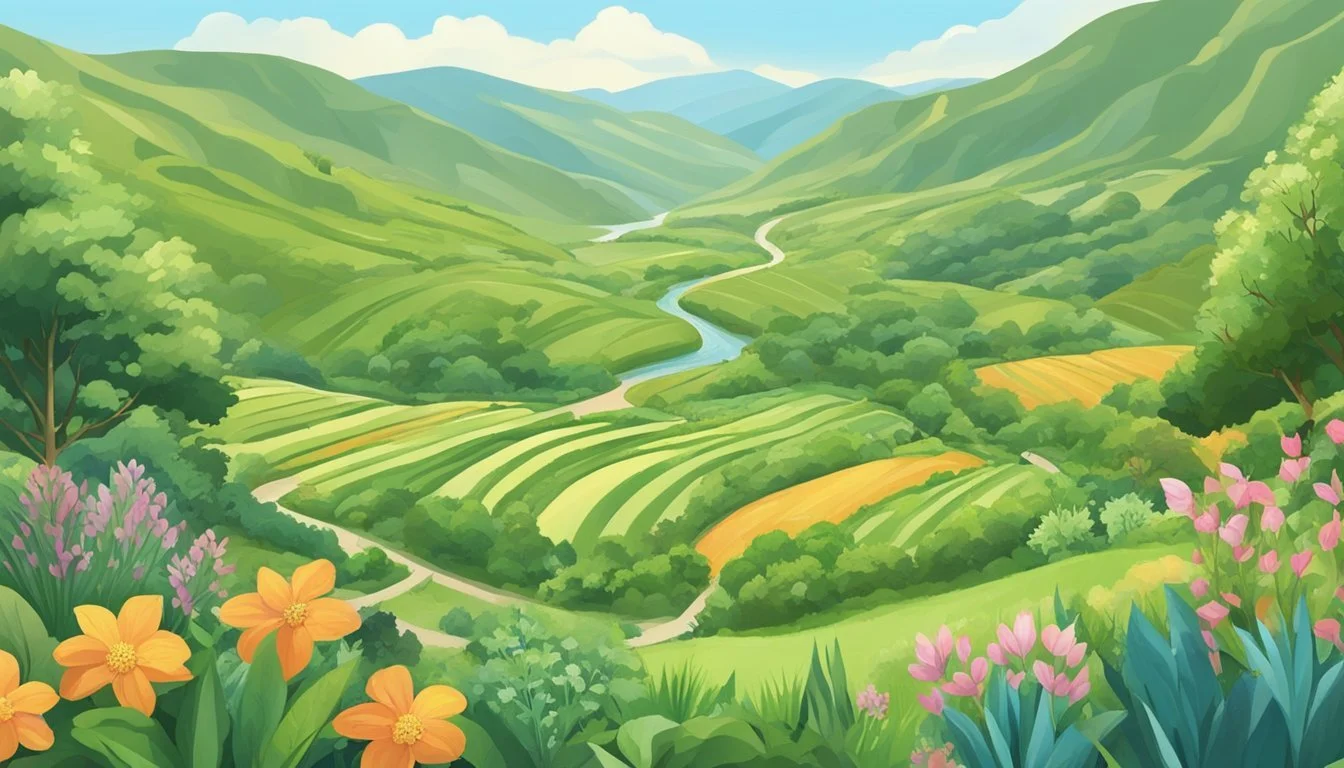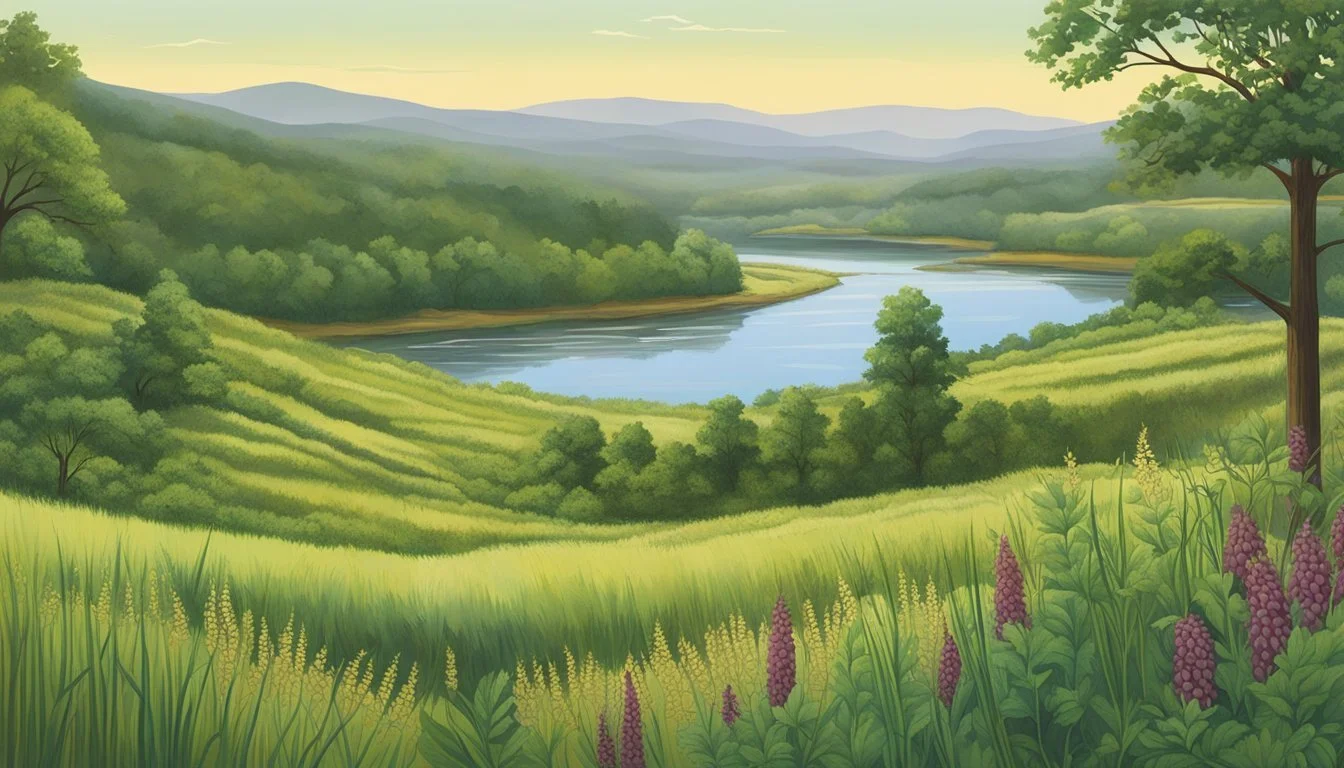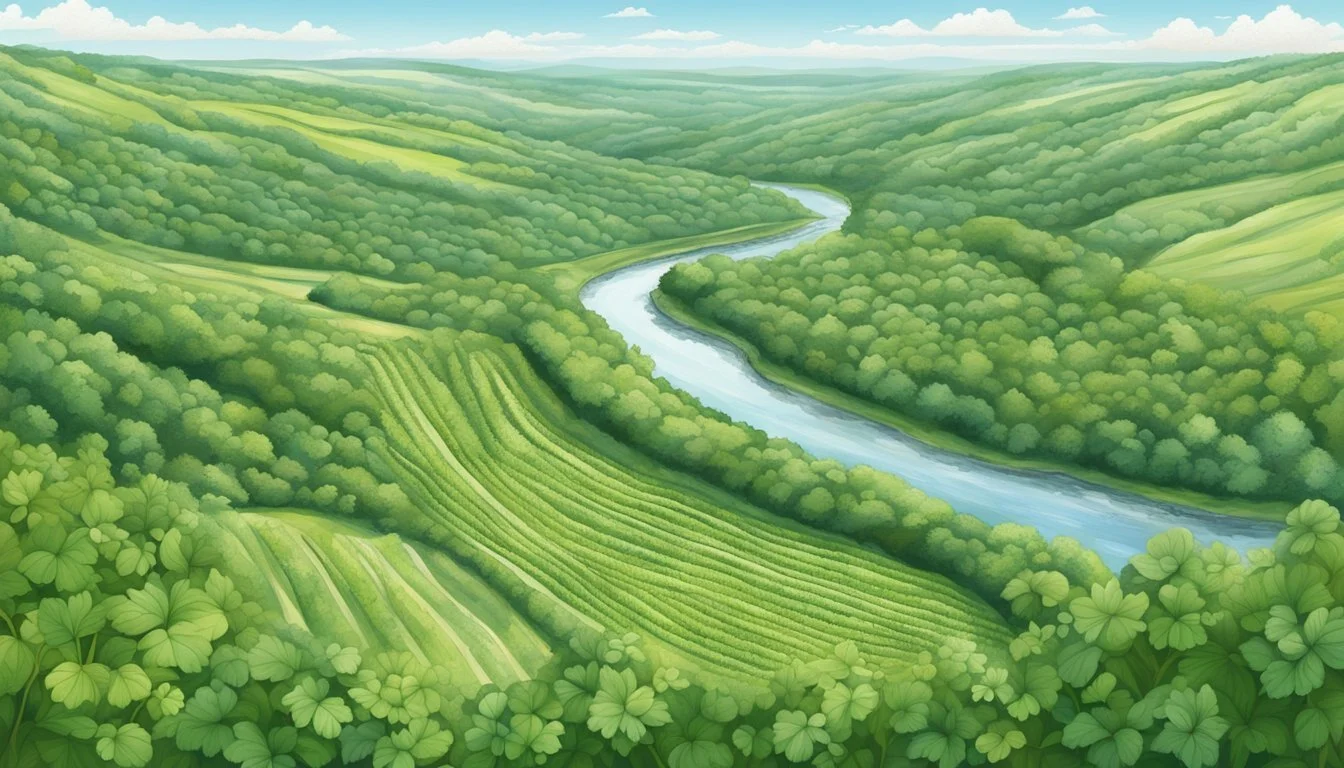Red River Valley Native Edible Plants
A Guide to Foraging Local Flora
Exploring the Red River Valley offers not only scenic views but also a treasure trove of native edible plants, each brimming with unique flavors and nutritional benefits. With the rich biodiversity in California, enthusiasts can discover a variety of plants that are both native to the region and safe to consume. From the vibrant Allium species, known for their wild onion flavors, to the sweet and nourishing fruits like those of the Pacific Blackberries and native strawberries, these plants provide a direct and enriching connection to the land.
Understanding which native plants are edible can enhance one's foraging experience while ensuring safety and respect for the ecosystem. Red maids (Calandrinia menziesii) stand out with their tasty leaves, offering a delightful addition to salads or cooked dishes. Other versatile edible plants include the Bigleaf Maple (Acer macrophyllum), whose flowers and sap provide raw treats and cooked syrups, respectively.
The Red River Valley is not just a haven for seasoned foragers but also an inviting landscape for newcomers. With the right knowledge, people can enjoy sustainable harvesting of these native edibles, savoring the flavors that have been part of California's natural heritage for centuries.
Historical Context
The Red River Valley boasts a rich history where native food plants played a critical role. This heritage evolved significantly from the practices of Native Americans to the agricultural advances of early settlers.
Native American Usage
Native Americans in the Red River Valley relied extensively on the region's plants for sustenance, medicine, and material culture. They utilized tallgrasses and wetlands to harvest a variety of edible and medicinal plants. For instance, many native plants that thrived in this area were cultivated and consumed, such as wild rice, which was a staple in their diet.
Heritage was preserved through the knowledge of which plants were edible and how they should be prepared. Techniques like roasting tubers and fermenting certain berries were common. The Red River Valley’s native plants were not just food but a crucial part of the cultural and spiritual life of the Native American tribes.
Early Settlers and Agriculture
With the arrival of early Euro-American settlers, the agricultural landscape of the Red River Valley transformed. Settlers introduced new farming techniques and crops, shifting the ecosystem from wild tallgrass prairies to cultivated farmlands.
Crops such as wheat and corn became dominant, altering the region’s biodiversity. This shift not only changed the physical landscape but also impacted the native plants that were once abundant and essential to the indigenous population. Despite this transformation, some native plants remained significant, continuing to be used for food and traditional medicine.
Agriculture became the backbone of the region’s economy, shaping the way land was used and perceived in the Red River Valley.
Native Plant Profiles
In the Red River Valley, a variety of native edible plants thrive, offering both nutritional and ecological benefits. Here, we explore some key categories—berries, nuts, herbs, and succulents—that populate this region.
Berry Plants
Berry plants in the Red River Valley are vital components of local ecosystems. Species like huckleberry, strawberries, raspberries, and blue elderberry are common.
Strawberries (Fragaria spp.) are particularly abundant, offering sweet fruits that are delicious both fresh and cooked. Raspberries (Rubus spp.) and blue elderberry (Sambucus nigra ssp. canadensis) are also plentiful; they provide significant nutritional value, rich in vitamins and antioxidants.
Huckleberries (Vaccinium spp.) are smaller but equally nutritious. These berries are not only important for human consumption but also support local wildlife, acting as a food source for birds and mammals.
Nut-Bearing Plants
Nut-bearing plants in this region provide another nutritious bounty. Hollyleaf cherry (Prunus ilicifolia) produces small, black cherries that contain edible seeds. These nuts can be roasted and eaten or ground into flour.
Various species of oaks (Quercus spp.) also dot the landscape, their acorns being a traditional food source. After proper leaching to remove tannins, acorns can be ground into a meal or flour, used in numerous culinary applications.
These plants not only serve as a food source but also contribute to soil health and provide vital habitat for wildlife, making them integral to the local ecosystem.
Herbaceous Plants
Herbaceous plants such as wild onions (Allium spp.) and other edible greens like bigleaf maple (Acer macrophyllum) play a significant role.
Wild onions are often found in grassy areas and are used much like their cultivated counterparts. They add flavor to a variety of dishes and have both nutritional and medicinal properties.
Bigleaf maple offers edible flowers and sap that can be cooked down into syrup. This plant adds diversity to the local diet and is relatively easy to forage, making it a valuable resource.
Cacti and Succulents
Cacti and succulents like the prickly pear cactus (Opuntia spp.) and barberry (Berberis spp.) thrive in the drier parts of the Red River Valley.
The prickly pear cactus is notable for its edible pads (nopales) and fruit (tunas). Nopales can be grilled, sautéed, or boiled, while the sweet, juicy tunas are consumed fresh or made into jellies and jams.
Barberry and Oregon grape (Mahonia spp.) both produce small berries that are edible, though they are often tart. These berries are high in vitamin C and are typically used in preserves or as flavoring agents in various dishes.
These plants are not only sources of food but are also adapted to withstand the valley's climatic conditions, making them a sustainable choice for local gardeners and foragers.
Ecological Significance
The native edible plants of the Red River Valley play a vital role in maintaining local ecosystems and contributing to habitat conservation. They offer sustenance to various wildlife species and help prevent the spread of non-native weeds.
Contribution to Local Ecosystems
Native edible plants in the Red River Valley serve as a crucial food source for local wildlife, including birds, mammals, and insects. Wild berries and nuts, for instance, provide essential nutrients, aiding animal survival during different seasons. Additionally, these plants maintain soil health through nitrogen fixation and prevent erosion with their deep root systems.
Another key aspect is their limited resource competition with native fauna. Unlike non-native species, local plants evolve symbiotically with local wildlife, ensuring balanced ecosystems. This natural equilibrium helps reduce reliance on artificial pest control and fertilizers, promoting a more sustainable environment.
Native plants also support pollinators, such as bees and butterflies, by offering nectar and pollen. This boosts pollination, which is vital for the reproduction of many plant species, including agricultural crops. By fostering a thriving pollinator population, native plants indirectly support local agriculture and food security.
Role in Habitat Conservation
Maintaining native edible plants contributes significantly to habitat conservation. They form the backbone of various habitats, from wetlands to forests, and help sustain biodiversity. The presence of these plants ensures diverse ecosystems, stabilizing food webs and providing shelter to numerous species.
By outcompeting non-native weeds, native plants help maintain the integrity of local habitats. Non-natives often disrupt ecosystems, leading to declines in indigenous species. Native plants, with their established ecological roles, resist such invasions and keep ecosystems resilient.
Furthermore, conservation of these plants supports cultural heritage. Indigenous communities have long relied on them for food, medicine, and ecological knowledge. Preserving these species ensures the continuity of valuable traditions and practices, enriching cultural landscapes alongside conserving biological resources.
Native edible plants in the Red River Valley are thus indispensable for both ecological sustainability and cultural preservation, making their conservation a priority for sustaining the region's environmental health.
Cultivation Tips
Growing and maintaining edible plants in the Red River Valley demands attention to soil, water, and climate conditions. Harvesting also requires understanding the right time and methods for best yields.
Planting and Maintenance
Soil Preparation: Ensuring fertile and well-drained soil is essential. Adding organic compost can significantly boost soil health, especially for berry bushes like blackberries and raspberries.
Watering: Most native plants in the Valley require moderate watering. Regular, deep watering encourages deep root growth which results in healthier plants. Mulching helps retain soil moisture and suppresses weeds.
Spacing: Adequate spacing prevents overcrowding and promotes air circulation, reducing the risk of diseases. For instance, wild onions (Allium spp.) should be planted about 6 inches apart.
Pruning: Routine pruning encourages new growth and improves plant vigor. For shrubs like salmonberry, annual pruning after the fruiting season is recommended.
Harvesting and Storing
Timing the Harvest: The right timing is crucial. Wild grapes and raspberries should be picked when fully ripe for maximum flavor. Regular checks are necessary to harvest at peak ripeness.
Harvest Methods: Use clean, sharp tools to avoid damaging the plant. For example, cut wild onions at the base, ensuring to leave some part intact for regrowth.
Storage Tips: Freshly harvested fruits can be stored in a cool, dry place. For long-term storage, consider drying or freezing. Pinyon pine nuts, for instance, can be dried and stored in airtight containers.
Foraging Precautions: While foraging, accurate identification is vital. Eating unknown plants can be hazardous. Consulting guides or foraging experts can prevent mishaps.
By paying attention to these tips, gardeners can enjoy a healthy and productive yield of native edible plants in the Red River Valley.
Edible Plant Uses
Red River Valley native edible plants offer diverse applications, providing both culinary delights and medicinal benefits. These uses highlight the practical utility and cultural significance of these plants in everyday life.
Culinary Applications
Native edible plants from the Red River Valley can be transformed into a variety of culinary dishes. Prickly Pear Cactus produces fruits and pads that can be consumed. The fruits, often called tunas, can be used to make jams, jellies, and syrups. The pads, known as nopales, are commonly grilled or boiled and included in salads or as sides.
Chia seeds, another native plant, are praised for their high protein and nutrient content. These seeds are mixed into smoothies, puddings, or baked goods, enhancing nutritional profiles. Yucca roots can be cooked similarly to potatoes, offering a starchy side dish. Fresh Allium peninsulare bulbs can be used in cooking similarly to onions, providing a flavorful addition to various recipes.
Medicinal & Therapeutic
Beyond culinary uses, many of these plants hold medicinal value. Yucca contains compounds believed to have anti-inflammatory properties and can be used in teas or supplements to support joint health. Traditional uses include concoctions made from its roots to treat ailments such as arthritis.
Prickly Pear Cactus is noted for its potential to manage blood sugar levels, and its juice is often incorporated into health regimens.
Guayacán, a woody plant, has been traditionally used to make teas aimed at soothing digestive issues. Its bark and leaves are considered valuable for their therapeutic properties.
These plants' utilitarian roles extend far beyond the kitchen, enriching life with their health benefits and historical significance.
Foraging Practices
Foraging for edible plants has specific practices to ensure sustainability and safety. Key points include respecting the environment and knowing the best places to forage.
Ethical Foraging
Ethical foraging involves practices that protect natural habitats and maintain plant populations. Respect the environment by only taking what you need and leaving enough for wildlife and plant regeneration.
Avoid overharvesting by collecting small amounts from various plants rather than clearing an area. This ensures that plant populations remain healthy and can continue to thrive.
Learn from experts. Workshops and guided tours, like those offered by the Santa Barbara Botanic Garden, can provide valuable knowledge and field experience to novice foragers.
Foraging Locations
Choosing proper foraging locations ensures both safety and sustainability. The Southern California coast offers diverse flora, including beaches and coastal scrublands.
Public lands with foraging permissions are ideal places, while private lands require permission from the owner. Protected areas like national parks and preserves often have strict regulations, so verify before foraging.
Urban environments and community gardens can also be abundant with wild edibles, but always check for contamination risks such as pesticides or pollutants.
Good foraging practices include familiarizing oneself with local flora and ecosystems to benefit from a more successful and responsible foraging experience.
Environmental Adaptations
Native plants in the Red River Valley have developed unique adaptations to thrive in their environments. Factors such as climate, soil, and topography play vital roles in shaping these adaptations.
Plants and Climate
The Red River Valley's climate features wide temperature variations and distinct seasons. Native plants have evolved mechanisms to withstand cold winters and hot summers. Tallgrass prairie species often possess deep root systems, allowing them to access water during dry periods.
Wetland areas in the valley support species that are flood-tolerant, such as cattails and willows. These plants can survive and reproduce despite periodic submersion. Adaptations like these ensure that native species can thrive in a range of climatic conditions.
Drought resistance is another common adaptation. Plants like the Prairie Blazing Star have developed thick leaves to minimize water loss. These climate-driven adaptations enable plant survival and propagation in the valley's dynamic weather patterns.
Soil and Topography
Soil composition and topographic features of the Red River Valley significantly influence plant distribution. The valley's rich, loamy soils are ideal for many grassland species, providing necessary nutrients. Grasses like Big Bluestem and Switchgrass are well-suited to these fertile soils.
In hill and valley regions, plant species vary according to elevation and exposure. For example, oak savannas on higher ground exhibit different plant communities compared to lowland floodplain forests. Each topographic niche supports species adapted to its specific conditions.
Some native plants have specialized to grow in alkaline soils found in certain valley segments. These plants often exhibit adaptations to tolerate higher pH levels. Understanding soil and topography helps explain the wide diversity of native plants in the Red River Valley.
Conservation Efforts
Efforts to conserve native plants in the Red River Valley are multifaceted, involving the protection of existing flora and active restoration projects. These initiatives help to maintain biodiversity and sustain local ecosystems.
Protecting Native Flora
Conservation actions focus on safeguarding native plant species from habitat loss and environmental pressures. Seed banks play a crucial role, storing genetic material from species like the western yew to safeguard against extinction.
Educational outreach programs aim to raise public awareness about the importance of preserving native plants. Workshops and community events provide practical advice on sustainable practices, such as responsible foraging and native plant gardening. These efforts collectively contribute to the long-term preservation of California native plants and other regional species.
Restoration Projects
Restoration projects are vital for rehabilitating degraded landscapes in the Red River Valley. These projects often involve replanting native species in areas impacted by agriculture or urban development. Programs may include steps like soil stabilization, erosion control, and habitat reconstruction.
Several initiatives collaborate with local universities and conservation groups to conduct research and implement effective strategies. Restoration sites, such as the FEP near Crookston, Minnesota, are monitored to track progress and adapt methods as needed. This collaborative approach ensures the creation of resilient ecosystems that support wildlife and maintain natural biodiversity.
Cultural Significance
Native edible plants of the Red River Valley hold deep cultural importance, reflecting the heritage and knowledge of local communities, especially Native Americans. They continue to influence various aspects of modern society.
Traditional Knowledge
Native Americans have long used these plants for food, medicine, and ceremonies. Knowledge of plant species, such as wild rice and prairie turnips, was passed down through generations. This symbiotic relationship with nature ensured sustainable harvesting techniques and contributed to cultural practices.
Specific plants were often used in rituals to honor the land and ancestors. The nutritional and medicinal properties of these plants were crucial for survival, especially during harsh seasons. Families would teach children about plant identification, ethical harvesting, and preparation methods.
Modern-Day Applications
Today, the cultural heritage of native edible plants is celebrated and preserved. Local communities and organizations are incorporating traditional plants into educational programs and culinary arts. They are featured in local markets and restaurants, emphasizing organic and sustainable food sources.
Modern medicine also recognizes the benefits of these plants. Studies highlight their nutritional value, and they are used in dietary supplements. Efforts are being made to cultivate these plants in community gardens to ensure their availability for future generations.
Promoting these plants supports biodiversity and connects people to their cultural roots. Whether used in traditional or new ways, they remain an integral part of the Red River Valley’s heritage.
Plant Identification
Plant identification involves examining specific characteristics and comparing them to known species to accurately determine the plant type. This process is crucial for distinguishing native edible plants in the Red River Valley.
Identifying Features
To identify plants, one should begin by observing the leaves. For example, woodland strawberries (Fragaria vesca) have trifoliate leaves with toothed margins. Elderberries (Sambucus spp.) display compound leaves arranged in pairs.
Bladderpod (Peritoma arborea) features silvery leaves covered in fine hairs, an identifying trait. Stems are another key feature; they can be smooth, rough, or hairy, and their color and thickness help in differentiation. For instance, the stem of Atriplex lentiformis is typically grayish-green, fitting well with its common habitat.
Flowers provide additional clues for identification. Prunus ilicifolia, recognized by its small white flowers clustered on lengthy spikes, is distinct. Observing these features helps in the precise identification of edible native plants.
Comparative Analysis
Comparative analysis involves examining multiple plants side by side to highlight differences and similarities. Woodland strawberries can be compared to wild strawberries to note differences in leaf size and texture. Elderberries can be differentiated from similar-looking plants by their distinct berry clusters and leaf patterns.
Comparing Atriplex lentiformis and Peritoma arborea involves looking at leaf shape and habitat preferences. Atriplex thrives in saline environments, whereas Peritoma prefers arid conditions.
Prunus ilicifolia contrasts with other cherry species by its leaf serrations and flower arrangements. Understanding these comparisons is essential for correctly identifying and utilizing native edible plants in the Red River Valley.











